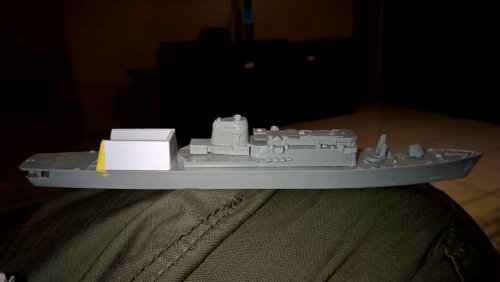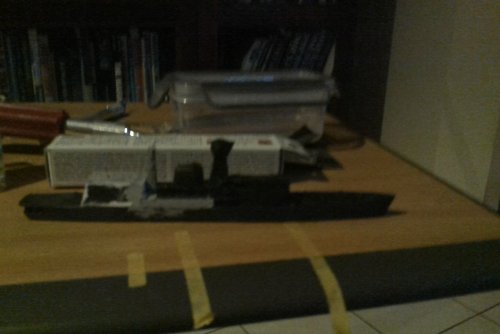I don't want to hijack Tony's alternate navy, but this thread has inspired me to do some thinking around the Type 82 and what an all-gas version cut down for economy and focused on air-defence might look like given the common strands most of us have discussed regarding armament options.
This is my what-if ideal Type 82 design.
My ramblings began with a basic what-if; move the Sea Dart forward and replace it with a hangar for 3x Sea Kings. Scaling from HMS Tiger showed Bristol's helideck to be almost the same length as Bristol's quarterdeck, a large hangar located at the forecastle break would also fit, flush with the hull sides. From there I began a fresh sheet design, paring back the barest essentials to get a decent air-defence destroyer of modest cost without the flagship extras and relying on helicopters as its ASW element.
Dimensions: 435ft 6in (oa) length; 55ft beam; 21ft draught (over sonar dome), 16ft (hull). Bigger than Type 42 Batch I but smaller than County, Type 82 and 42 Batch III.
Machinery: Two 24,000shp Olympus TM1 giving 48,000shp plus two 3,500shp Proteus 10M for cruising. Two Proteus seems insufficient for cruising, Type 42 with two later 5,340shp Tyne RM1C made 18kts for example. Other ideas are four Tynes coupled if such an arrangement could work with an Olympus on the same shaft. I think Type 82 is just slightly too early for marine Tynes.
Speed: 30kts (deep and clean)
Displacement: 4,500-4,750 tons standard, my ball-park estimate
Armament:
1x2 3in L/70 Mk.8, in this scenario the RN keeps the 3in L/70 and fits it instead of the 4.5in Mk.6 in frigates. I have designed a 'Mk.2' mounting with an unmanned GRP mounting which should be lighter and would incorporate a few changes to boost reliability, not so good for the anti-ship role, but in her role as an air-defence ship they can knock-down incoming aircraft as an inner layer of defence. Control by Type 909 over forward arcs or the two MRS-3 GWS-22 directors aft which should have ok arcs forward and aft for a three-channel control.
2x1 20mm Orkileon
1x2 Sea Dart SAM (38 missiles), fire-control by two Type 909
2x2 Sea Cat 2 SAM (36 missiles), fire-control by two MRS-3. The supersonic Sea Cat development goes ahead in this scenario as a cheap supersonic SAM which uses all the existing elements (launchers, fire-control) of the GWS-22 Sea Cat. Offers a good close-range SAM system to deal with leakers and is backed up by the 3in gun. I'm not totally happy about shipping two of the older MRS-3 but I envision a newer director for the 1970s or even replacement with Confessor.
2x Sea King or Wessex helicopters. My Type 82 is not a general purpose design as such, she is not optimised for anti-submarine warfare to save money for Ikara equipped helicopters. Soviet SSNs and SSGs and SSGNs are the main threat, stand-off missiles can be dealt with by the SAMs and guns. Any ASW weapon needs range and speed, what's better than a large Sea King? Superior to MATCH Wasp and Ikara won't fit this hull anyway. No Limbo, if an SSN is that close then the carrier you're protecting is in big doo-doos anyway. Also, sonar cut back to just the Type 184.
Radars: Electronics as the real Type 82, except one change. An off-shoot of the NIGS programme the New Surveillance Radar, what this was in real-life is still an unknown. In my scenario its the culmination of the ASWE is a single-rotating array 3-D radar equivalent to the SPS-52. Small and lighter than Type 988 and probably more achievable too.
The end result is very Type 42-ish, I admit I had one eye on that type as I sketched this out, but I think it looks less 'bloated' than Bristol which had a very strange superstructure layout compared to other post-war designs.




